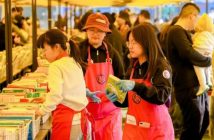
American Charlene Wang served for six years as a diplomat with the US State Department in Bangladesh, China, India, and at the UN Security Council Policy Office. Three years ago. she created a Beijing-based social enterprise called Tranquil Tuesdays to introduce China’s highest-quality teas to the world. Her business combines her passion for tea with a mission to provide steady employment, and vocational and life skills training to disadvantaged Chinese women. She recently visited Grade 6 and 7 students at Beijing BISS International School to talk about the finer points of tea.

Ms. Shrimpton, School Counselor, US/UK
How do you control the quality of tea?
The number one factor in China is when it was picked. The early season usually [yields]higher-quality leaves than later in the season.
Secondly it’s the leaf itself and how it was grown. You could have a handmade leather boot or you could have a boot off a factory line, with a very different quality. It’s the same for tea. The really cool thing is that the majority of Chinese tea is still produced in small family farms.
Another big factor in quality is leaf size. There’s a big difference between drinking dirt-like tea [from a tea bag]and drinking whole leaf tea; it’s like having powdered Tang and then fresh-squeezed orange juice.

Prochchhanno, 12, Bangladesh
How is English tea different from Chinese tea?
No European countries produce tea; they import it from subtropical and tropical regions.

Carlo, 12, Italy
What is your favorite type of tea?
It depends on the season. When it’s cold, I like Qimen black tea or Pu’er tea but when it’s hot, I like white teas and green teas.

Ing, 12, Thailand
How do you produce so many teas from one plant?
The main [factor]is oxidation. When you bite into an apple and leave it out, then it changes color – that’s oxidation. The tea maker’s job is to control that process. If it’s not oxidized, that’s green tea; fully oxidized tea is black.

Bowen, 11, US
How do you make money?
I find tea that I like, drink it to make sure that it tastes great, teach people about enjoying tea, and sell them the tea that I find. You have a good business mind! Do you want an internship? Because I like the way you think.

Pim, 13, Thailand
How do you know when the tea leaf is ready to be picked?
On the top of the tea plant is a bud and two leaves. [Generally] you pick [that part], and it takes one or two weeks for the next batch to come up. Some teas, like silver needle white tea, are made only from the bud, and others like Tieguanyin oolong are made only from the leaves.

Huijun, 13, Korea
How many different types of teas are there?
There are six main categories: white, green, yellow (which is very rare), oolong, black, and post-processed tea like Pu’er. Within each category, there are hundreds more. For example, there are hundreds of green teas and oolong teas in China.

Ashley, 12, Hong Kong
Can you tell us a little bit about yellow tea?
Yellow tea is rare; it’s produced in only four places in China. It’s green tea [with an extra]step; you put it in a covered bag or box and you let it ferment for a couple of hours. That makes the flavors a little bit softer, sweeter, and not as grassy. That’s also what makes it yellow.

Maria, 11, Spain
How many years have you been working with tea?
I have been crazy about tea since I was in third grade, I’ve been traveling around and going to tea gardens on my own for at least ten years and I’ve had my company for three and a half years.

Janvi, 11, India
How many places are famous for tea?
The five most famous places are China (the oldest and biggest), Japan (mostly green tea), India (in Darjeeling and Assam), Sri Lanka (black tea), and Rwanda or Tanzania.
The British brought tea to India, Sri Lanka and Africa since they were all post-colonial [places]. They wanted to control the tea [trade]so they sent a Scottish spy dressed up as a Chinese guy to steal tea plants and bring them to India. I’m not joking, look it up! His name was Robert Fortune, and there’s a whole book on the subject called For All the Tea in China by Sarah Rose.

Manoli, 12, Germany
When was tea invented?
There are records from as early as 1,000 BC of tea cultivation in China, but the number one story the discovery of tea is about Emperor Shennong, a mythological character whose name means “sacred farmer.” The story is that he was outside and a [tea]leaf fell in his cup. But that’s not necessarily the most historically-accurate account.
photos by KEN
This article originally appeared on p50-51 of the beijingkids December 2013 issue.
Check out the PDF version online at Issuu.com



